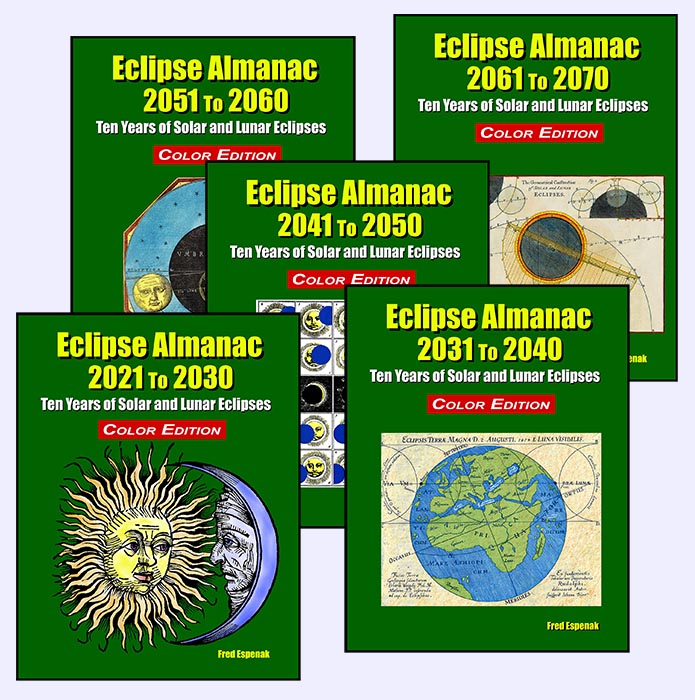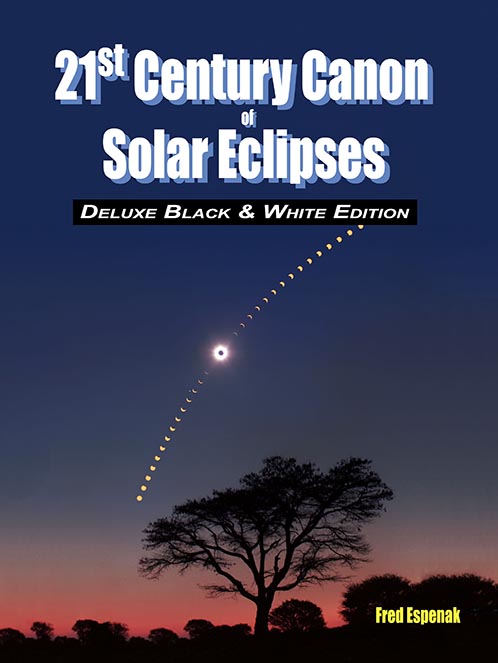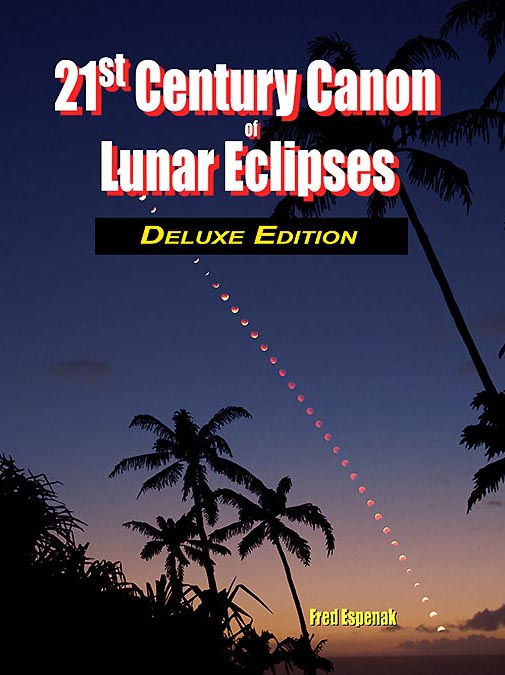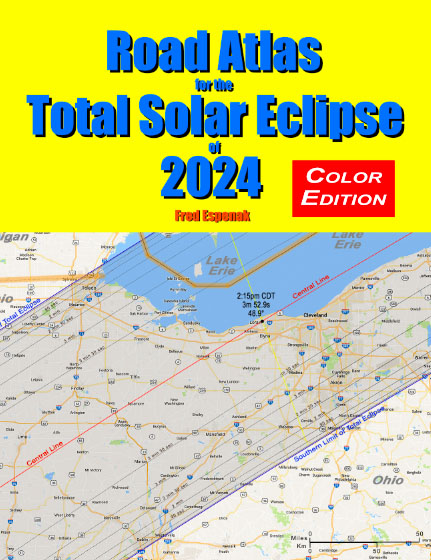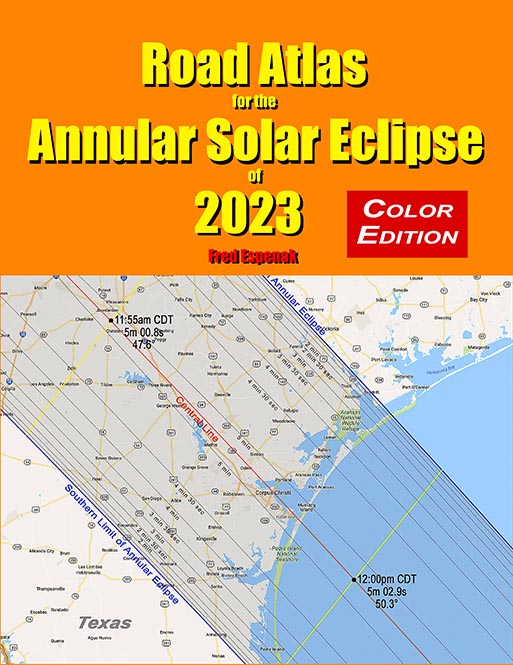Atlas of Central Solar Eclipses in the USA
By Fred Espenak
|
Atlas of Central Solar Eclipses in the USA Black & White Edition 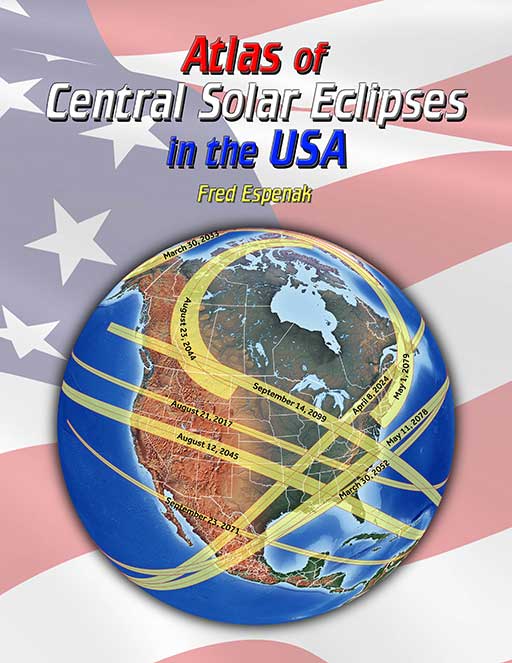
Standard Black & White Edition $18.99 |
Atlas of Central Solar Eclipses in the USA Color Edition 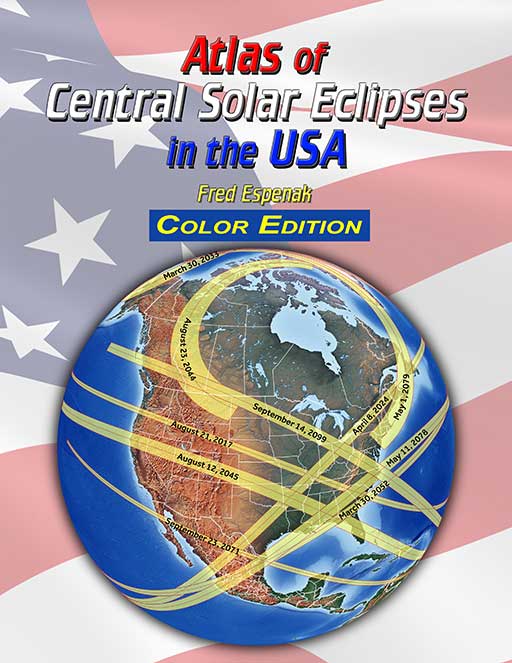
Deluxe Color Edition $25.99 |
Description
With the upcoming total solar eclipse of 2017 August 21, certain questions naturally arise as to the frequency of these events. When was the last total eclipse through the USA and when is the next? How often do they happen? What total eclipse tracks passed across the USA during the 17th, 18th, and 19th centuries, etc., and what states did they include? And how often is a total solar eclipse visible from each of the 50 states?
In 2012 the track of an annular solar eclipse passed through the western USA. The same questions can be asked about this type of eclipse as well.
The Atlas of Central Solar Eclipses in the USA answers all of these questions. It contains of a comprehensive series of 499 global maps showing the geographic track of every single total and annular solar eclipse across the USA (including Alaska and Hawaii) during the two-thousand-year period 1001 through 3000. It is accompanied by a catalog that lists the major characteristics of each eclipse including its duration and whether it is visible from the lower 48 states, Alaska and/or Hawaii.
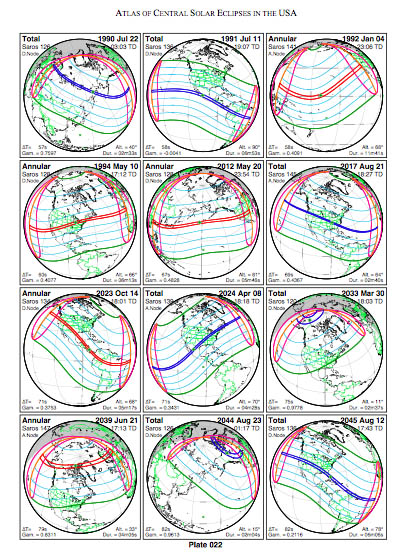
Global Map of Central Eclipses from 1990 to 2045 (click to enlarge) |
Finally, a set of 20 detailed maps, each covering a 50-year period and centered on the lower 48 states, shows the path of every central eclipse (total or annular). The maps include state boundaries and the location of major cities. This allows quick determination as to whether a particular eclipse was visible from any state or city in question. These maps also cover southern Canada and northern Mexico.
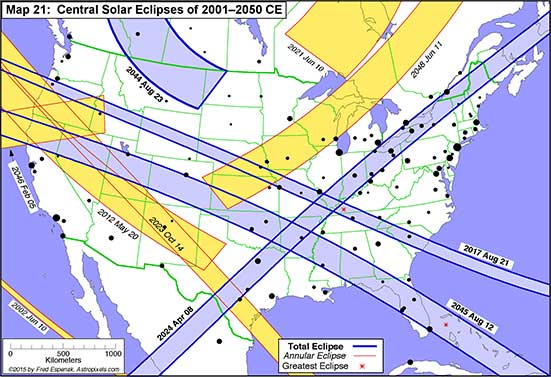
Map of Central Eclipses from 2001 to 2050 (click to enlarge) |
There is something compelling about the pattern of eclipse tracks crossing familiar places many hundreds of years in the past and future. It was this fascination that inspired the creation of the Atlas.
Order:
- Atlas of Central Solar Eclipses in the USA (Black & White Edition)
- Atlas of Central Solar Eclipses in the USA (Color Edition)
Total Solar Eclipses in the USA
Read the blog post Total Solar Eclipses in the USA, which is based on this publication.
About the Author
Click the following link to read a brief biography on Fred Espenak.
- Page from Global Eclipse Maps
Atlas of Central Solar Eclipses in the USA - Sample page:
Also Available...
Eclipse Almanac
The Eclipse Almanac is a series of five publications. Each one is a concise reference for every eclipse of the Sun and the Moon over a 10-year period. This compendium identifies when and where each of these events will be seen. Particular details about each eclipse are included, as well as a 25-year table looking further into the future.
Section 1 presents solar eclipses including an explanation of why they occur, types of solar eclipses, and the visual appearance of each. Global maps depict the geographic regions of visibility of each of the 22 to 23 solar eclipses.
Section 2 covers lunar eclipses explaning why they occur, the types of lunar eclipses, and the appearance of each. Detailed figures illustrate each of the 22 to 23 lunar eclipses including the Moon's path through Earth's shadows, and a map of the geographic visibility of every eclipse.
Section 3 lists the date and time of the Moon’s phases over the decade.
The five volume Eclipse Almanac series covers the decades from 2021 to 2070.
For more information visit Eclipse Almanac.
21st Century Canon of Solar Eclipses
The 21st Century Canon of Solar Eclipses contains maps and data for all 224 solar eclipses occurring during the 100-year period from 2001 through 2100. The eclipse predictions are based on the Jet Propulsion Lab's DE405 - a computer ephemeris used for calculating high precision coordinates of the Sun and Moon for hundreds of years into the past and future.
Section 1 of the Canon presents the fundamentals about solar eclipses. Section 2 discusses the eclipse the predictions, the constants used. A statistical analysis of eclipse frequency, extremes in eclipse magnitude, greatest central duration and quincena combinations are covered in Section 3. A concise explanation of the data contained in the solar eclipse catalog (Appendix A) and detailed descriptions of the solar eclipse maps.
The primary content of the "21st Century Canon" resides in the four appendices. Appendix A is a comprehensive catalog of solar eclipses. Appendix B is an atlas of maps (12 per page) depicting the geographic regions of visibility of each eclipse. Appendix C zeros in on full-page maps each solar eclipse. Curves of Maximum Time and Curves of Eclipse Magnitude permit the estimation of time and magnitude from any geographic location. Finally, Appendix D plots the track of every central eclipse (total, annular and hybrid) on large scale maps to allow the identification of countries and major cities within each eclipse path.
For more information visit 21st Century Canon of Solar Eclipses.
21st Century Canon of Lunar Eclipses
The 21st Century Canon of Lunar Eclipses contains figures, maps and data for all 228 lunar eclipses occurring during the 100-year period from 2001 through 2100. The eclipse predictions are based on the Jet Propulsion Lab's DE431 - a computer ephemeris used for calculating high precision coordinates of the Sun and Moon for hundreds of years into the past and future.
Section 1 of the Canon presents the fundamentals about lunar eclipses. Section 2 discusses the eclipse the predictions and the enlargement of Earth's shadows. An analysis of eclipse frequency, and the extremes in penumbral and umbral eclipse magnitudes, and durations of penumbral, partial and total eclipses are covered in Section 3.
The primary content of the "21st Century Canon" resides in the three appendices. Appendix A is a comprehensive catalog of lunar eclipses. Appendix B is an atlas of diagrams (12 per page) depicting the Moon's path through Earth's shadows and the geographic region of visibility of each eclipse. Appendix C zeros in on the lunar eclipses with a detailed full-page path diagrams and maps of each eclipse.
For more information visit 21st Century Canon of Lunar Eclipses.
Atlas of Central Solar Eclipses in the USA
The Atlas of Central Solar Eclipses in the USA contains of a series of 499 global maps showing the geographic track of every total and annular solar eclipse across the USA (including Alaska and Hawaii) during the two-thousand-year period 1001 through 3000. It is accompanied by a catalog that lists the major characteristics of each eclipse including its duration and whether it is visible from the lower 48 states, Alaska and/or Hawaii.
A set of 20 detailed maps, each covering a 50-year period and centered on the lower 48 states, shows the path of every total and annular eclipse. The maps include state boundaries and major cities. These maps also cover southern Canada and northern Mexico.
For more information visit Atlas of Central Solar Eclipses in the USA.
Road Atlas of the Total Solar Eclipse of 2024
The Road Atlas for the Total Solar Eclipse of 2024 contains a comprehensive series of 26 maps of the path of totality across Mexico, the USA and Canada. The large scale (1 inch ≈ 22 miles) shows both major and minor roads, towns and cities, rivers, parks, and mountains.
Although a partial eclipse will be seen from all of North America, the total phase in which the Moon completely covers the Sun (known as totality) will only be seen from within the 120-mile-wide path of the Moon’s umbral shadow as it sweeps across Mexico, the United States (Texas, Oklahoma, Arkansas, Missouri, Tennessee, Kentucky, Illinois, Indiana, Ohio, Michigan, Pennsylvania, New York, Vermont, New Hampshire, and Maine), and Canada (Ontario, Quebec, New Brunswick, Prince Edward Island, Nova Scotia and Newfoundland).
Armed with this atlas and the latest weather forecasts, the road warrior is ready to chase totality no matter where it takes him/her along the entire path. This mobile strategy offers the highest probability of witnessing the spectacular 2024 total eclipse in clear skies.
For more information visit Road Atlas for the Total Solar Eclipse of 2024.
Road Atlas of the Annular Solar Eclipse of 2023
The Road Atlas for the Annular Solar Eclipse of 2023 contains a series of 29 maps of the path of annularity across the USA, Mexico, Central and South America. The large scale (1 inch ≈ 28 miles) shows both major and minor roads, towns and cities, rivers, parks, and mountains.
The annular eclipse phase in which the Moon is completely silhouetted in front of the Sun (known as annularity) will only be seen from within the 115 to 137 mile-wide path of the Moon’s antumbral shadow as it sweeps across the United States (Oregon, California, Idaho, Nevada, Utah, Colorado, Arizona, New Mexico, and Texas), Mexico, Central and South America.
Armed with this atlas and the latest weather forecasts, the road warrior is ready to chase annularity no matter where it takes him/her along the entire path. This mobile strategy offers the highest probability of witnessing the amazing 2023 annular eclipse in clear skies.
For more information visit Road Atlas for the Annular Solar Eclipse of 2023.


